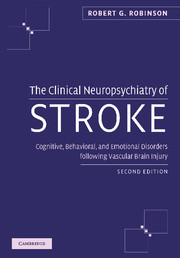 The Clinical Neuropsychiatry of Stroke
The Clinical Neuropsychiatry of Stroke Book contents
- Frontmatter
- Contents
- Preface
- Part I Introduction
- Part II Poststroke depression
- 5 Diagnosis of depression
- 6 Prevalence of depressive disorders
- 7 Phenomenology and specificity of depressive symptoms
- 8 Natural course of depression
- 9 Delayed-onset depression
- 10 Relationship to lesion location
- 11 Relationship of depression to cerebral dominance and structural asymmetries
- 12 Relationship of depression to bilateral hemisphere brain injury
- 13 Relationship of depression to physical impairment
- 14 Relationship to cognitive impairment and treatment
- 15 Relationship of aphasia to depression
- 16 Relationship of depression to social functioning
- 17 Relationship to premorbid risk factors
- 18 Mortality and treatment
- 19 Suicidal thoughts and plans
- 20 Biological markers
- 21 Mechanisms of poststroke depression
- 22 Treatment of poststroke depression
- 23 Prevention of poststroke depression
- Part III Poststroke mania
- Part IV Poststroke anxiety disorders
- Part V Other poststroke disorders
- Index
15 - Relationship of aphasia to depression
from Part II - Poststroke depression
Published online by Cambridge University Press: 01 October 2009
- Frontmatter
- Contents
- Preface
- Part I Introduction
- Part II Poststroke depression
- 5 Diagnosis of depression
- 6 Prevalence of depressive disorders
- 7 Phenomenology and specificity of depressive symptoms
- 8 Natural course of depression
- 9 Delayed-onset depression
- 10 Relationship to lesion location
- 11 Relationship of depression to cerebral dominance and structural asymmetries
- 12 Relationship of depression to bilateral hemisphere brain injury
- 13 Relationship of depression to physical impairment
- 14 Relationship to cognitive impairment and treatment
- 15 Relationship of aphasia to depression
- 16 Relationship of depression to social functioning
- 17 Relationship to premorbid risk factors
- 18 Mortality and treatment
- 19 Suicidal thoughts and plans
- 20 Biological markers
- 21 Mechanisms of poststroke depression
- 22 Treatment of poststroke depression
- 23 Prevention of poststroke depression
- Part III Poststroke mania
- Part IV Poststroke anxiety disorders
- Part V Other poststroke disorders
- Index
Summary
Aphasia remains one of the most perplexing problems for investigators of neuropsychiatric disorders following stroke. Since the diagnoses of all neuropsychiatric disorders requires subjective responses by the patient to verbal or written questions, the existence of even a moderate degree of comprehension deficit may represent a severe obstacle to the diagnoses of numerous neuropsychiatric disorders. This conundrum has led almost all investigators of poststroke neuropsychiatric disorders to exclude patients with moderate or severe comprehension deficits from their studies (Robinson et al. 1983; House et al. 1990; Astrom et al. 1993).
In spite of the fact that almost all investigations of poststroke depression have excluded patients with comprehension aphasia, the hypothesized cause of many poststroke depressive disorders has been aphasia (Gainotti 1972; Benson 1979). Gainotti (1972) hypothesized that the depressive-catastrophic reaction associated with left hemisphere lesions represented an understandable response of depression and angry outbursts to the loss of language because language represents one of the most important elements of the patient's life. Similarly, Benson (1979) hypothesized that depression sometimes represents a secondary psychological reaction to the loss of language. As a result of the exclusion of patients with comprehensive aphasia (e.g., fluent aphasias and global aphasias) two major questions arise. First, what is the true prevalence of depression among patients with aphasia.
- Type
- Chapter
- Information
- The Clinical Neuropsychiatry of StrokeCognitive, Behavioral and Emotional Disorders following Vascular Brain Injury, pp. 171 - 178Publisher: Cambridge University PressPrint publication year: 2006


